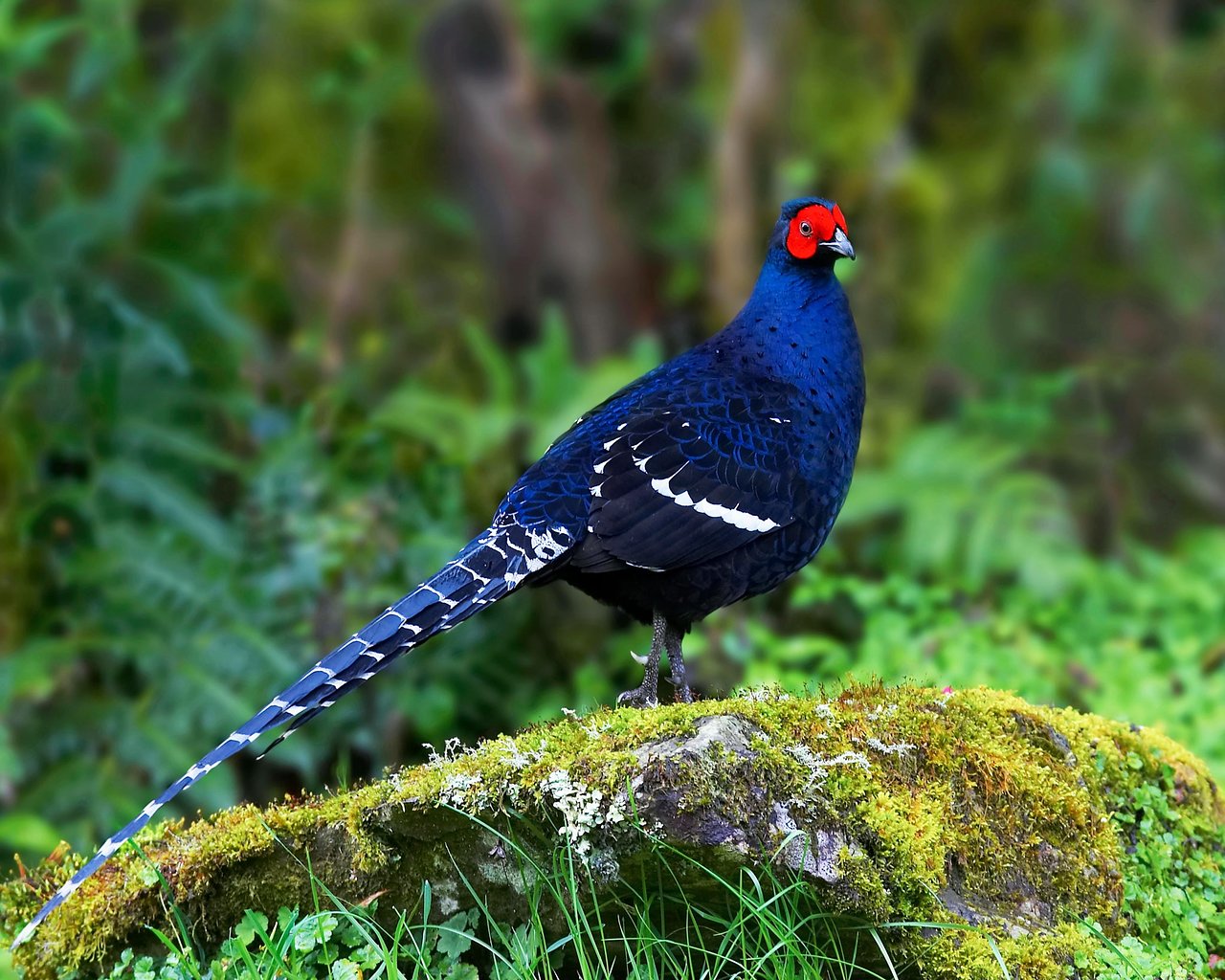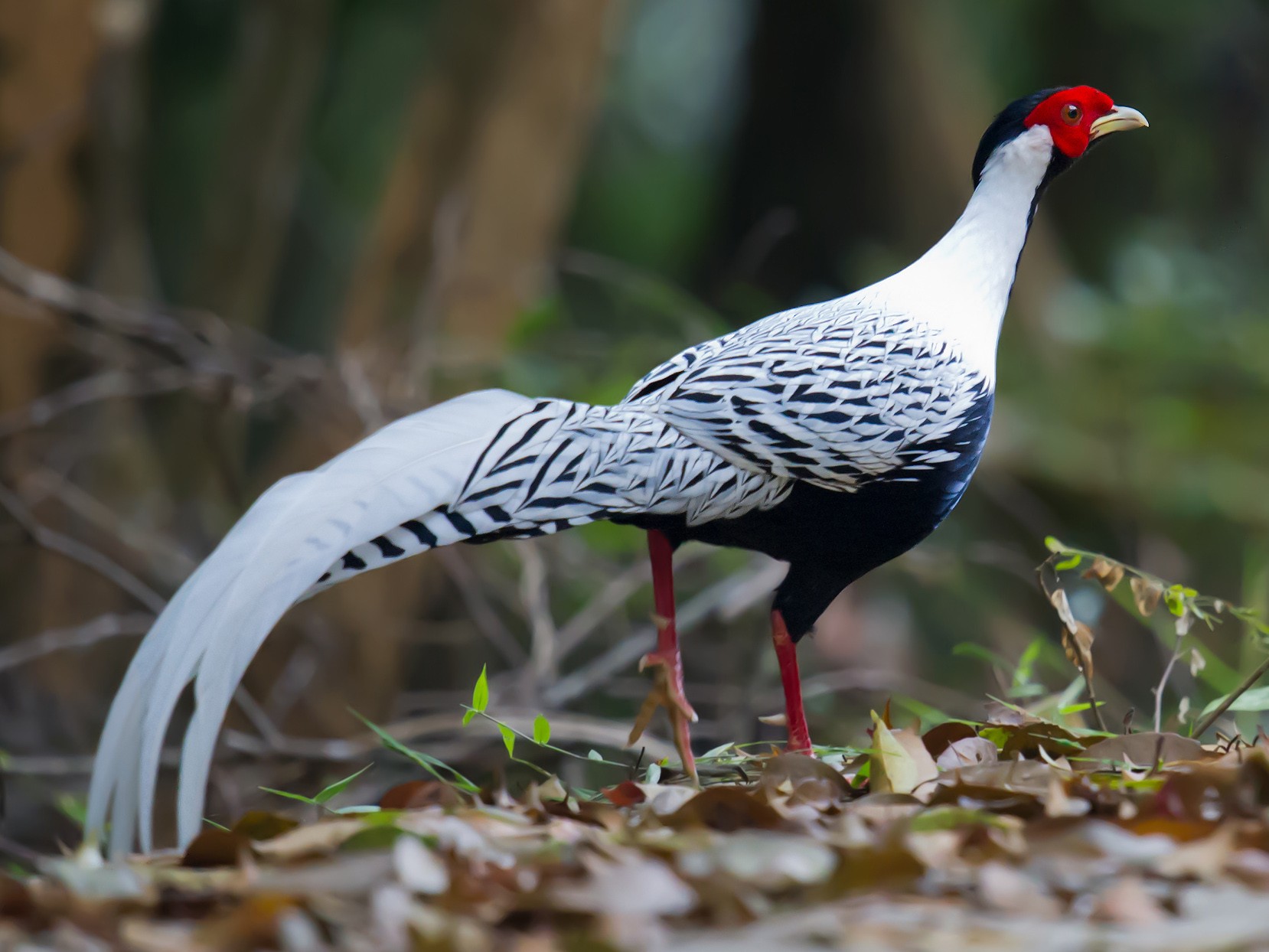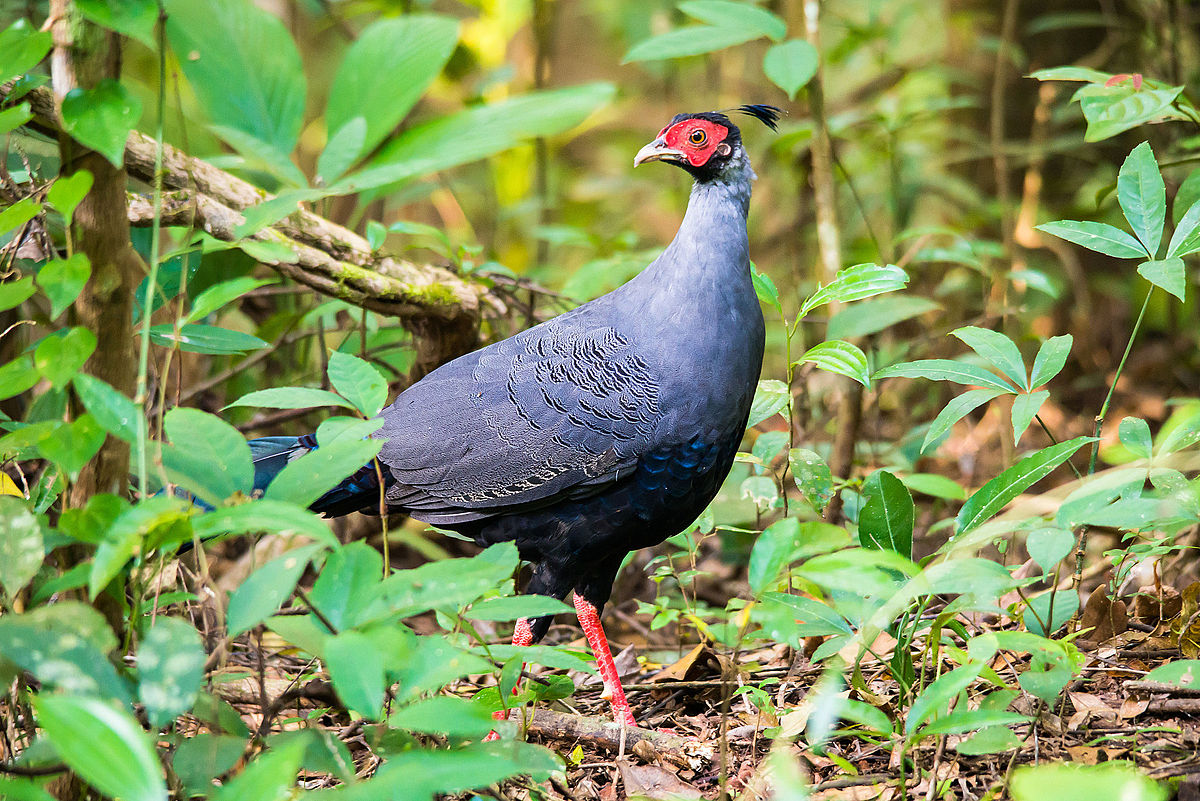Pheasants are a group of heavy, ground-feeding birds that belong to the same order as turkeys, chickens, and other landfowl. They have been hunted for meat for over 200 years in the United States and longer in other parts of the world.
However, their beauty and elegance are often underrated as a group. In this article, we will take a look at ten of the most beautiful types of pheasants and discover their locations, habitats, and behavior.
You are reading: Take A Look At These Beautiful Types Of Pheasants
From the unmistakable golden pheasant to the stunning Siamese fireback, these birds are sure to impress with their vibrant colors and unique features.

10 Types Of Pheasants
Golden Pheasant

The Golden Pheasant, also known as the Chinese Pheasant and Rainbow Pheasant, is a gamebird of the order Galliformes and the family Phasianidae.
The male Golden Pheasant is unmistakable with its golden crest and bright red body. It also features colors in orange, yellow, blue, black, and tan. The female Golden Pheasant, on the other hand, has mottled brown plumage and is less showy than the male.
These birds are native to forests in mountainous areas of western China, but feral populations have been established in many other countries, including the United Kingdom, Canada, the United States, Mexico, Colombia, Peru, Bolivia, Chile, Argentina, Uruguay, the Falkland Islands, Germany, Belgium, the Netherlands, France, Ireland, Australia, and New Zealand.
Lady Amherst’s Pheasant
Lady Amherst’s Pheasant (Chrysolophus amherstiae) is a bird of the order Galliformes and the family Phasianidae. The male Lady Amherst’s Pheasant is unmistakable with its blue, dark green, white, and yellow plumage.
It has a red crest, blue-green bare skin around its eyes, and a long, greyish-white tail with black bars and red streaks at the base. The chest and belly are white, and the throat is scaled green, while the back is dark green. The female Lady Amherst’s Pheasant, on the other hand, has rich rufous-brown plumage, heavily barred black overall.
The underparts are usually paler than the upperparts. These birds are native to southwestern China and far northern Myanmar, but they have been introduced elsewhere, such as England and other countries. Lady Amherst’s Pheasants search for leaves, grain, and insects in the dense forests of their habitats.
Silver Pheasant

The Silver Pheasant (Lophura nycthemera) is a species of pheasant found in forests, mainly in mountains, of mainland Southeast Asia and eastern and southern China, with an introduced population on Victoria Island in Nahuel Huapi Lake, Neuquén, Argentina.
Here are some facts about the Silver Pheasant:
Physical Characteristics
– The male Silver Pheasant is black and white, while the female is mainly brown.
– Both sexes have a bare red face and red legs, which separates it from the greyish-legged kalij pheasant.
– The long-tailed male has either white or silvery-gray plumage.
Habitat
– Silver Pheasants are found in forests, mainly in mountains, of mainland Southeast Asia and eastern and southern China.
Diet
– Silver Pheasants feed on seeds, berries, insects, and other small invertebrates.
Conservation Status
– The Silver Pheasant is common in aviculture and overall remains common in the wild, but some of its subspecies are rare and threatened.
Interesting Facts
– The Silver Pheasant is an ancient breed, mentioned nearly 5,000 years ago in Chinese poetry.
– The Silver Pheasant is a popular gamebird and is often found in hunting preserves.
Mikado Pheasant
The Mikado Pheasant (Syrmaticus mikado) is a gamebird in the pheasant family Phasianidae of the order Galliformes, gallinaceous birds. Here are some facts about the Mikado Pheasant:
Physical Characteristics
– The male Mikado Pheasant is a rich slaty blue with white markings and red facial skin, while the female is rich brown with extensive pale markings.
– With the tail included, males of this species can reach up to 1.5 meters in length.
Habitat
– The Mikado Pheasant is endemic to mountainous regions of Taiwan.
– The species occupies dense shrubs, bamboo growth, and grassy terrain with conifer overstory in central and southern Taiwan, from 2000 to 3200 meters above sea level.
Diet
– The Mikado Pheasant feeds on seeds, fruits, and insects.
Conservation Status
– The Mikado Pheasant is considered a species of “Least Concern” by the International Union for Conservation of Nature (IUCN).
Interesting Facts
– The Mikado Pheasant is sometimes considered an unofficial national bird of Taiwan, along with the Swinhoe’s Pheasant and Taiwan Blue Magpie.
– A pair of Mikado Pheasants and Yushan National Park, one of the areas it is known to inhabit, is depicted in the 1000 dollar bill of the New Taiwan dollar.
– The Mikado Pheasant is one of the long-tailed pheasants belonging to the same genus (Syrmaticus) as the Copper, Reeves, Bartailed, and Elliot’s pheasants.
Kalij Pheasant
Read more : Can Birds Eat Honey
The Kalij Pheasant (Lophura leucomelanos) is a species of pheasant found in forests and thickets, especially in the Himalayan foothills, from Nepal, Pakistan to western Thailand. Here are some facts about the Kalij Pheasant:
Physical Characteristics
– Males are rather variable depending on the subspecies involved, but all have at least partially glossy bluish-black plumage, while females are overall brownish.
– Both sexes have a bare red face and greyish legs (the latter separating it from the red-legged silver pheasant).
Habitat
– The Kalij Pheasant is found in forests and thickets, especially in the Himalayan foothills, from Nepal, Pakistan to western Thailand.
Diet
– The Kalij Pheasant feeds on seeds, berries, insects, and other small invertebrates.
Conservation Status
– The Kalij Pheasant is generally common and widespread, though three of its eastern subspecies (L. l. oatesi, L. l. lineata, and L. l. crawfurdi) are considered threatened and L. l. moffitti is virtually extinct.
Interesting Facts
– The Kalij Pheasant is one of the forest-dwelling birds found in the southern foothills of the Himalayas.
– The Kalij Pheasant is one of the most widely hunted gamebirds in Uttaranchal, India.
– The male Kalij Pheasant has a distinctive call, which is a series of loud, sharp, and high-pitched whistles.
Reeves’s Pheasant
Reeves’s Pheasant (Syrmaticus reevesii) is a large pheasant within the genus Syrmaticus and is endemic to China. Here are some facts about Reeves’s Pheasant:
Physical Characteristics
– The male Reeves’s Pheasant is brightly plumaged with a scaled golden white and red body plumage, grey legs, brown iris, and bare red skin around the eye. The head is white with a black narrow band across its eyes. The male has an extremely long silvery white tail barred with chestnut brown.
– The female Reeves’s Pheasant is less showy, with mottled brown plumage.
Habitat
– Reeves’s Pheasant is found in hill forests of central and eastern China.
Diet
– Reeves’s Pheasant feeds on seeds, berries, insects, and other small invertebrates.
Conservation Status
– Reeves’s Pheasant is considered a species of “Least Concern” by the International Union for Conservation of Nature (IUCN).
Interesting Facts
– Reeves’s Pheasant is named after the British naturalist John Reeves, who first introduced live specimens to Europe in 1831.
– The male Reeves’s Pheasant has the longest natural tail feather of any bird, as mentioned in the 2008 edition of Guinness World Records.
– Reeves’s Pheasant is a popular gamebird and has been introduced to parts of Europe, such as France.
Ring-Necked Pheasant
The Ring-Necked Pheasant (Phasianus colchicus) is a game bird in the pheasant family Phasianidae of the order Galliformes, gallinaceous birds. Here are some facts about the Ring-Necked Pheasant:
Physical Characteristics
– The male Ring-Necked Pheasant has a metallic green head, white neck ring, and a rust-brown body with dark markings. The female is mottled brown with darker markings.
– Both sexes have a bare red face and greyish legs.
Habitat
– Ring-Necked Pheasants are native to Asia and parts of Europe, but they have been introduced to many other countries, including the United States.
– They occupy grassland and farmland habitats, preferring relatively open cover, such as grass and stubble fields, and are found in habitats with grass, ditches, hedges, marshes, and tree stands or bushes for cover.
Diet
– Ring-Necked Pheasants feed on seeds, berries, insects, and other small invertebrates.
Conservation Status
– Ring-Necked Pheasants are not considered threatened, but their populations have declined in some areas due to habitat loss and hunting pressure.
Interesting Facts
– Ring-Necked Pheasants are one of the most popular game birds in the United States and are often raised on game farms for hunting.
– The Ring-Necked Pheasant is the state bird of South Dakota.
– The Ring-Necked Pheasant is sometimes called the “Chinese Pheasant” because it is native to China.
Cheer Pheasant
The Cheer Pheasant (Catreus wallichii), also known as Wallich’s Pheasant or Chir Pheasant, is a vulnerable species of the pheasant family, Phasianidae. Here are some facts about the Cheer Pheasant:
Physical Characteristics
– Cheer Pheasants are large, pale pheasants with a long tail, an untidy crest, and red skin around the eye.
– The male is pale gray, barred throughout, with thick black bands on its tail feathers. Its long tail has 18 feathers, and the central tail feathers are much longer. The color is mainly gray and brown.
– The female is slightly smaller in overall size and has buffy gray plumage.
Habitat
– Cheer Pheasants are native to the southern foothills of the western Himalayas, from Pakistan to western Nepal.
Diet
– Cheer Pheasants feed on roots, tubers, bulbs, seeds, insects, and other small invertebrates.
Conservation Status
– Cheer Pheasants are considered a vulnerable species due to habitat loss and hunting pressure.
Interesting Facts
– Cheer Pheasants are monogamous and breed on steep cliffs during the summer with a clutch of 10 to 11 eggs.
– Cheer Pheasants are very vocal, and their calls can carry for over a mile.
– Cheer Pheasants are strong fliers and can fly for short distances.
Impeyan Pheasant
The Himalayan Monal, also known as Impeyan Monal or Impeyan Pheasant, is a pheasant native to Himalayan forests and shrublands at elevations of 2,100–4,500 m. It is part of the family Phasianidae and is listed as Least Concern on the IUCN Red List.
The male Himalayan Monal is a large, colorful bird with a metallic green head, red neck, green shoulders, blue back, orange tail, and black underparts. The female is less showy, with a pale blue eye patch, white throat, and streaky brown body.
The Himalayan Monal is the national bird of Nepal, where it is known as the danphe or danfe, and state bird of Uttarakhand, India, where it is known as monal. The scientific name commemorates Lady Mary Impey, the wife of the British chief justice of Bengal, Sir Elijah Impey.
The Himalayan Monal is found in Himalayan hill forests, typically in areas with extensive rhododendron and bamboo-dominated understory. It feeds on roots, tubers, bulbs, seeds, insects, and other small invertebrates.
The Cheer Pheasant (Catreus wallichii) is another pheasant species found in the southern foothills of the western Himalayas, from Pakistan to western Nepal. It is a large, pale pheasant with a long tail, an untidy crest, and red skin around the eye.
The male is pale gray, barred throughout, with thick black bands on its tail feathers. Its long tail has 18 feathers, and the female is slightly smaller in overall size and has buffy gray plumage.
Cheer Pheasants are monogamous and breed on steep cliffs during the summer with a clutch of 10 to 11 eggs. They feed on roots, tubers, bulbs, seeds, insects, and other small invertebrates.
Siamese Fireback

The Siamese Fireback (Lophura diardi), also known as Diard’s Fireback, is a fairly large pheasant, approximately 80 cm long.
The male has a grey plumage with an extensive facial caruncle, crimson legs and feet, ornamental black crest feathers, reddish-brown iris, and long curved blackish tail. The female is a brown bird with blackish wing and tail feathers.
Read more : How Long Do Budgies Sleep
The Siamese Fireback is distributed to the lowland and evergreen forests of Cambodia, Laos, Thailand, and Vietnam in Southeast Asia. This species is also designated as the national bird of Thailand.
The female usually lays between four and eight rosy eggs. The scientific name commemorates the French naturalist Pierre-Médard Diard. The Siamese Fireback is a remarkably plumaged terrestrial bird of lowland and foothill broadleaf forests, most often encountered on trails and roadsides in the early morning.
The male whistles loudly to attract females. The Siamese Fireback is listed as Least Concern on the IUCN Red List, but it is suspected to be experiencing a slow to moderate population decline owing to continued habitat loss and degradation and ongoing hunting pressure.
FAQS
1. What are pheasants?
Pheasants are a group of heavy, ground-feeding birds that belong to the same order as turkeys, chickens, and other landfowl.
2. What do pheasants eat?
Pheasants eat a wide variety of foods including insects, seeds, leaves, grains, roots, berries, spiders, earthworms, and snails.
3. Where are pheasants found?
Pheasants are found in many parts of the world, including Asia, Europe, and North America.
4. What are some of the most beautiful types of pheasants?
Some of the most beautiful types of pheasants include the Golden Pheasant, Silver Pheasant, Kalij Pheasant, Ring-Necked Pheasant, Lady Amherst’s Pheasant, Reeves’s Pheasant, Mikado Pheasant, Himalayan Monal, Cheer Pheasant, and Siamese Fireback.
5. Are pheasants hunted for meat?
Yes, pheasants have been hunted for meat for over 200 years in the United States and longer in other parts of the world.
6. What is the national bird of Nepal?
The Himalayan Monal, also known as Impeyan Monal or Impeyan Pheasant, is the national bird of Nepal.
7. What is the state bird of Uttarakhand, India?
The Himalayan Monal, also known as Impeyan Monal or Impeyan Pheasant, is the state bird of Uttarakhand, India.
8. Are pheasants native to the Rocky Mountain West?
No, pheasants are not native to the Rocky Mountain West. They evolved in Asia, where some conditions were similar to the West, but most were very different.
9. What is the flight speed of pheasants?
The flight speed of pheasants is 38 to 48 mph when cruising, but when chased, they can fly up to 60 mph.
10. What is the scientific name of the Golden Pheasant?
The scientific name of the Golden Pheasant is Chrysolophus pictus.
Source: https://petstutorial.com
Category: Birds










